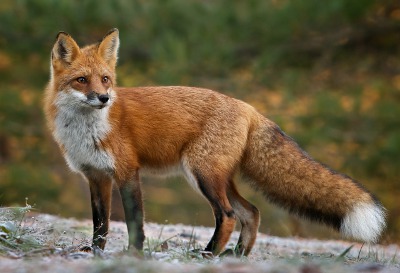Red Fox
Category: North American Mammals

Facts about Red Fox, "Scientific name for Red Fox is Vulpes vulpes". The Red Fox is a Vulpes type of fox that comes from the Canidae family. The Red Fox hail from smaller-sized forerunners from Eurasia, and they are the largest of the exact foxes and the most copious affiliate of the Carnivora. The Red Fox have been spread across the whole Northern Hemisphere, ranging from the Arctic Circle to Central America, North Africa and Asia. The Red Fox has increased beside human growth, having been set up in Australia, where it is measured injurious to native animals and bird populations. Due to the presence of the Red Fox variety in Australia, it is incorporated amid the list of the 100 worst enveloping species of the world.
Features of Red Fox
The Red Fox is a big-size animal that attains a body length, ranging from 18 inches (45.7 cm) to 35 inches (88.9 cm) up to tail with the length between 13 inches (33.02) and 21 inches (53.34) when matured. An adult Red Fox attains a height between 14 inches (35.56 cm) and 20 inches (50.8 cm) at the shoulder, with the ear length that ranges from 3 inches (7.6 cm) to 5 inches (12.7 cm) and the hind foot length between 5 inches (12.7 cm) and 7 inches (18 cm). The male Red Fox breeds are heavier by 15 % to 20 % than the females with a body mass between 4.9 pounds and 30.9 pounds. An adult Red Fox has a head measuring between 5.1 inches (12.95 cm) and 6 9/16 inches (16.7 cm), whereas the head of the female fox measures between 5 inches (12.7 cm) and 6 5/16 inches (16 cm).
The length of the front foot print of the Red Fox has a dimension of 2.4 inches (6 cm), with a breadth of 1.8 inches (4.5 cm), whereas its back foot print has a length of 2.2 inches (5.6 cm) and a breadth of 1.5 inches (3.81 cm). These foxes trot at a velocity, ranging from 6 to 13 kilometers per hour (3.7 to 8 mph), and have a maximum sprinting velocity of 50 kilometers per hour (31 mph). They boast a pace between 9.8 inches (24.9 cm) to 13.8 inches (35 cm) while walking at a normal speed.
The Red Fox has a lengthened body and comparatively short limbs. The tail of the Red Fox is longer than half of its body length, and it is fluffy and attains the earth while in a standing position. The pupils of the animal are oval in shape and are vertically oriented. They have nictitating membranes, but move only while the eyes are closed. The front feet have five paws, whereas their hind feet contain only four paws and without dewclaws. The Red Fox are extremely nimble, being competent of jumping more than a 2-meter fence or 6 foot fence, and they are good swimmers, too. Usually, female Red Foxes boast four pairs of teats, though females with 7, 9 and 10 number of teats are common. A male Red Fox has smaller testes than the foxes of the Arctic.
Usually, Red foxes are found together in small groups or pairs, which include families, such as a mated couple and their juvenile, or a male fox with many female foxes having affinity ties. The juveniles of the mated couple stay with their parents to help in taking care of new kits.
Even though the Red Fox is inclined to slaughter smaller predators, as well as other fox varieties, it is susceptible to attack from bigger predators, such as coyotes, wolves, golden jackals and average-sized and big-sized felines.
Diet of Red Fox
The Red Fox mostly feeds on little rodents, although it may also feed on game birds, rabbits, invertebrates, reptiles and juvenile ungulates. Sometimes they also feed on vegetable matter and fruit.
Reproduction of Red Fox
Red foxes mate during the spring season and they used to mate once in a year. The reproductive organs of a female Red Fox changes in size and shape earlier than two months of oestrus, usually in December. Normally, the litter size ranges from four to six kits, and they are born deaf, blind, and toothless, with dark tan feathery fur. The mother Red Fox stays with the kits for 2 to 3 weeks, during this stage, the father fox nourishes the mother fox.
The average life span of the Red Fox ranges from 2 years to 5 years in the wild.

 Back To Category North American Mammals
Back To Category North American Mammals